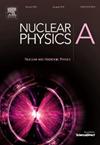Possible universal limit for valence parton distributions
IF 2.5
4区 物理与天体物理
Q2 PHYSICS, NUCLEAR
引用次数: 0
Abstract
We report the observation of the existence of a possible universal limit for valence parton distributions that should exist once partonic degrees of freedom are relevant for high energy scattering from strongly interacting bound systems like a nucleon, meson or a few nucleon system at very short distances. Our observation is based on the notion that the Bjorken x weighted valence parton distribution function has a peak, , that characterizes the average momentum fraction carried out by the valence quarks in the system. Within the residual mean-field model of the valence quark distribution we found that has an upper limit: , where is the number of valence quarks in the cluster embedded in the strongly interacting environment of the hadron. The existence of such a limit imposes a new constraint on choosing the starting resolution scale for PDFs. Our prediction for the nucleon is that , which is in agreement with all the available valence PDFs that employ the standard approach for selecting starting . We also demonstrate how the existence of this limit can be used to verify the onset of quark-cluster structures in short range nucleon correlations in nuclei.
价部子分布的可能普遍极限
我们报告了对价部子分布可能存在的普遍极限的观察,一旦部子自由度与强相互作用束缚系统(如核子、介子或几个核子系统)在很短距离上的高能散射相关,就应该存在价部子分布的可能普遍极限。我们的观察是基于这样一个概念,即Bjorken x加权价夸克分布函数有一个峰值xp,它表征了系统中价夸克的平均动量分数。在价夸克分布的剩余平均场模型中,我们发现xp有一个上限:xp≤12(nV−1),其中nV是嵌入强子强相互作用环境中的价夸克簇的数量。这种极限的存在对pdf的起始分辨率尺度Q0的选择提出了新的约束。我们对核子的预测是xp∣Q→Q0≤14,这与采用标准方法选择起始Q0的所有可用价态pdf一致。我们还演示了如何利用这一极限的存在来验证原子核中短距离核子相关中夸克簇结构的起始。
本文章由计算机程序翻译,如有差异,请以英文原文为准。
求助全文
约1分钟内获得全文
求助全文
来源期刊

Nuclear Physics A
物理-物理:核物理
CiteScore
3.60
自引率
7.10%
发文量
113
审稿时长
61 days
期刊介绍:
Nuclear Physics A focuses on the domain of nuclear and hadronic physics and includes the following subsections: Nuclear Structure and Dynamics; Intermediate and High Energy Heavy Ion Physics; Hadronic Physics; Electromagnetic and Weak Interactions; Nuclear Astrophysics. The emphasis is on original research papers. A number of carefully selected and reviewed conference proceedings are published as an integral part of the journal.
 求助内容:
求助内容: 应助结果提醒方式:
应助结果提醒方式:


